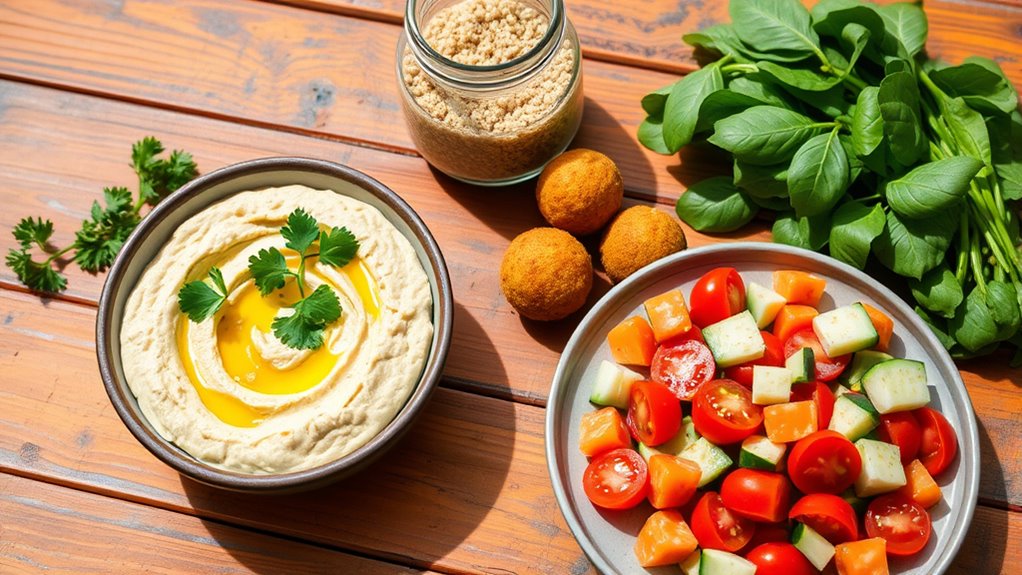To easily integrate plant-based protein into your meals, focus on versatile ingredients like lentils, chickpeas, tofu, tempeh, nuts, seeds, and grains like quinoa and brown rice. Prep large batches ahead of time and incorporate them into salads, stir-fries, soups, or grain bowls for variety. Add nuts and seeds to smoothies or oatmeal for extra protein. Exploring creative combinations can keep your meals exciting while supporting your health and sustainability goals—there’s more to discover on how to do this effectively.
Key Takeaways
- Incorporate a variety of plant proteins like legumes, tofu, nuts, and grains into daily meals for balanced nutrition.
- Prepare and cook legumes and grains in bulk to simplify adding them to salads, bowls, and soups.
- Use plant-based protein sources as main ingredients in recipes such as veggie burgers, stir-fries, and hearty stews.
- Enhance meals by adding nuts, seeds, and protein-rich vegetables to smoothies, oatmeal, and salads.
- Experiment with seasoning and marinating tofu and tempeh to match different cuisines, making plant proteins more flavorful and appealing.

Incorporating plant-based protein into your meals is an effective way to boost nutrition and support a sustainable diet. As you explore different protein sources, you’ll find that adding variety not only keeps your meals interesting but also guarantees you’re getting a broad spectrum of nutrients. Legumes like lentils, chickpeas, and black beans are fantastic staples for meal prep because they’re affordable, versatile, and packed with protein. You can cook a batch at the start of the week and incorporate them into salads, stews, or grain bowls, making it easy to maintain a high-protein intake without much daily effort. Tofu and tempeh are also excellent options, especially if you’re looking for plant-based proteins that can mimic the texture of meat. These ingredients absorb flavors well, so you can marinate or season them to suit any cuisine, from stir-fries to sandwiches.
Nuts and seeds, such as chia seeds, hemp seeds, and almonds, serve as nutrient-dense add-ons that boost the protein content of your meals. Incorporate them into smoothies, sprinkle over oatmeal, or mix into salads for an extra crunch and nutritional punch. When you plan your meals in advance, you can easily incorporate these small but mighty protein sources, ensuring you’re never short on essential amino acids. Meal prep becomes a breeze when you cook large quantities of beans or grains like quinoa and brown rice, which serve as reliable bases for a variety of dishes. These ingredients store well and can be combined with vegetables and plant proteins to create balanced, satisfying meals throughout the week.
Another key to integrating plant-based protein into your diet is to experiment with different recipes to keep things fresh. Stir-fry dishes, veggie burgers, and hearty soups are all ways to incorporate different protein sources seamlessly into your routine. Preparing ingredients ahead of time minimizes daily cooking and helps you stay committed to your nutritional goals. Plus, it reduces the temptation to opt for less healthy options when you’re pressed for time. As you build your meal prep routine, you’ll notice how easy it becomes to include a variety of plant-based proteins, which helps you meet your daily protein needs without relying on animal products. This approach not only benefits your health but also contributes positively to the environment by reducing your carbon footprint. Additionally, understanding the principles behind the Law of Attraction can motivate you to maintain consistent healthy habits and stay focused on your wellness goals.
Frequently Asked Questions
What Are the Best Plant-Based Protein Sources for Beginners?
You should start with simple, versatile plant-based proteins like beans, lentils, chickpeas, tofu, and tempeh. These are easy to incorporate into meals and provide a good protein combination. For meal prep tips, cook in batches and add them to salads, stir-fries, or grain bowls. As a beginner, focus on variety and balance, experimenting with spices and flavors to keep your meals exciting and nutritious.
How Can I Improve the Flavor of Plant-Based Protein Dishes?
You can improve the flavor of plant-based protein dishes by experimenting with spice combinations like cumin, paprika, and chili powder to add depth. Marinade techniques also make a big difference—marinate your proteins in citrus, soy sauce, or flavorful oils before cooking to infuse taste. Let the ingredients sit for at least 30 minutes to absorb the flavors, resulting in a more savory and satisfying dish.
Are There Any Health Risks Associated With High Plant-Based Protein Intake?
You might worry about health risks from eating lots of plant-based protein, but beware—excessive intake can lead to nutritional deficiencies or digestive issues. If you consistently overconsume, your body may miss out on essential nutrients like B12 or iron, or struggle with bloating and gas. Stay balanced by diversifying your sources, listening to your body, and consulting a healthcare professional to guarantee you’re nourishing yourself safely and effectively.
How Do I Ensure Complete Protein Intake on a Plant-Based Diet?
You can guarantee complete protein intake on a plant-based diet by focusing on proper protein pairing, combining foods like beans with rice or hummus with whole grain bread. This approach helps achieve amino acid completeness, ensuring your body gets all essential amino acids. Mix different plant proteins throughout the day, and consider incorporating a variety of legumes, grains, nuts, and seeds to meet your nutritional needs effortlessly.
Can Plant-Based Proteins Replace All Animal Proteins in My Diet?
Yes, plant-based proteins like meat alternatives can substitute all animal proteins in your diet, offering ample dietary flexibility. By combining different sources such as beans, lentils, tofu, and tempeh, you can meet your nutritional needs. Many meat alternatives are fortified with essential nutrients, making it easier to maintain a balanced diet. Just make certain you include a variety of plant proteins to get all necessary amino acids, and you’re good to go.
Conclusion
Adding plant-based protein to your meals is simple and beneficial, even if you’re worried about flavor or texture. With so many tasty options like beans, lentils, and tofu, you won’t miss meat. Plus, incorporating these proteins can boost your health and reduce your environmental impact. So, don’t hesitate to experiment—you might find your new favorite dish and enjoy the positive changes it brings to your diet and the planet.









